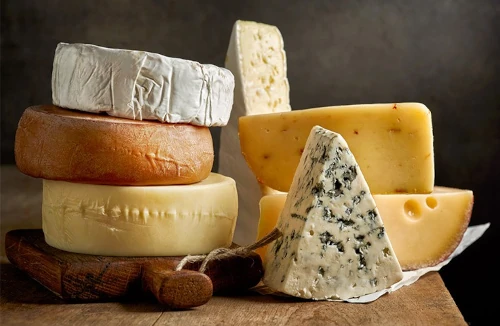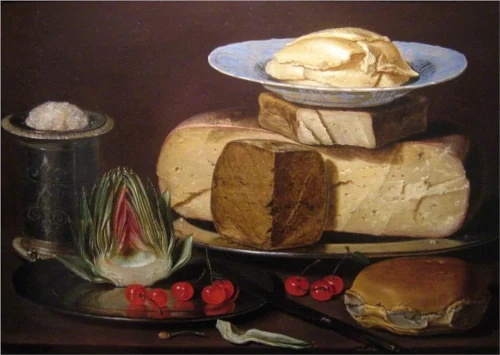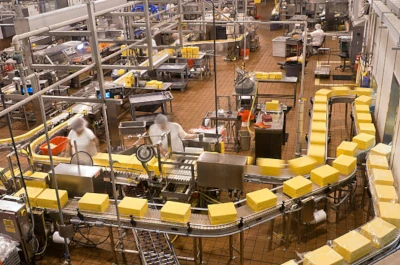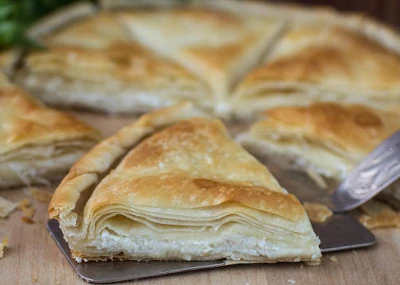The History of Cheese: A Tale of Time, Taste, and Tradition

Cheese is one of the world’s oldest known prepared foods. The history of cheese is a captivating tale that is as rich and varied as the multitude of flavors this extraordinary food item offers. This staple comfort food has been an integral part of our diets for thousands of years. From its accidental discovery to its spread across the globe, the journey of cheese is a testament to human ingenuity, culinary evolution, and our enduring love for this versatile food.
One of main reasons for the ubiquity of cheese-making is the food’s versatility, making it a beloved ingredient in cuisines around the world. From being the star ingredient in a classic French fondue or an Italian lasagna, to adding a rich depth to soups and sauces, or simply enhancing a sandwich or salad, cheese has the ability to transform and elevate a dish. It even features in popular desserts like cheesecake. Its wide range of textures and flavors, from creamy and mild to hard and pungent, allows it to be used in countless ways, whether in sweet or savory dishes, baked goods, or simply enjoyed on its own. This adaptability is part of what makes cheese such an enduring and universal culinary delight.
The Origin of Cheese
When was cheese invented? It wasn't so much an invention as a fortuitous accident. Cheese-making is an ancient tradition, dating back over 7,000 years. While the exact origin of cheese remains uncertain, it was likely discovered by accident by nomadic herders in regions such as the Middle East, Central Asia, or North Africa. These early pastoralists, among the first to domesticate animals like goats, sheep, and cattle, naturally sought ways to store and transport milk.
Milk was often carried in pouches made from animal stomachs, which contained rennet, an enzyme that causes milk to coagulate. The heat from the sun and natural bacteria in the milk triggered the separation of curds and whey. Instead of spoiling, the milk transformed into a more solid, tangy, and longer-lasting form—primitive cheese. This unexpected discovery provided a portable, protein-rich food source, ideal for early travelers and herders who needed nourishment on long journeys.
Early Evidence of Cheese-Making

From the tomb of Ptahmes,
mayor of Memphis
Archaeological discoveries provide some of the oldest known traces of cheese production:
- Polish Pottery (c. 5500 BCE): Perforated pottery shards from Neolithic settlements in Poland contain residues of milk fats, suggesting an early method of straining curds.
- Egyptian Tomb Murals (c. 2000 BCE): Ancient Egyptian tombs feature depictions of cheese-making, showing workers handling curds and storing cheese in woven baskets.
- Chinese Burial Site (c. 1615 BCE): A 3,800-year-old mummy in the Taklamakan Desert was found with clumps of an early form of cheese, indicating cheese-making had spread beyond the Middle East.
These findings suggest that cheese quickly became a staple food in ancient diets, valued for its ability to preserve the nutritional benefits of milk while being easy to store and transport.
Cheese in Early Civilizations
By 3000 BCE, cheese-making had advanced significantly. Ancient Sumerians and Mesopotamians refined the process, producing soft, tangy cheeses similar to modern ricotta or feta. Cheese gained further prominence in Greece, where it was woven into mythology and daily life. Homer’s Odyssey describes the Cyclops Polyphemus making and storing cheese in his cave, reflecting how deeply cheese was embedded in Greek culture. The Greeks also developed brined cheeses, like early feta, which remained a dietary staple for centuries.
As civilizations expanded, so did cheese-making techniques, evolving into an art form shaped by climate, culture, and necessity. From a lucky accident to a culinary cornerstone, cheese has played a fundamental role in human history—one that continues to evolve today.
Cheese Spreads Across Europe

Artichoke, and Cherries'
Clara Peeters, 1625
With the later expansion of the Roman Empire, cheese-making spread across Europe, reaching as far as the British Isles and the northernmost parts of the continent. The Romans, known for their gastronomic passion and agricultural ingenuity, were particularly fond of cheese. They saw it not just as a staple food, but as a delicacy that could be refined and perfected.
The Romans developed advanced cheese-making techniques, many of which are still in use today. They understood the importance of temperature control in the curdling process and the effects of different aging techniques on the texture and flavor of the cheese. They also began aging cheese to enhance its flavor, a practice that led to the creation of many varieties of cheese we know today, including cheddar and parmesan. Roman gourmands would have cheese courses at their meals, and their cookbooks included recipes for cheese dishes.
During the Middle Ages, as the Roman Empire declined, monastic communities became the custodians of cheese-making traditions. The monks, with their agricultural knowledge and attention to detail, were perfectly suited to the task of cheese-making. Each monastery developed its own unique type of cheese, often named after the monastery or the local region. This led to a proliferation of cheese varieties across Europe, each with its own distinct flavor, texture, and aging process.
France, in particular, became renowned for its cheese. The diverse climates and landscapes of France, from the lush pastures of Normandy to the rugged mountains of the Alps, provided ideal conditions for cheese-making. French monks and farmers experimented with different types of milk, aging processes, and flavoring agents, leading to the creation of over 400 types of cheese. From the creamy Brie and Camembert to the blue-veined Roquefort and the hard Comté, French cheeses are celebrated for their variety and quality.
Thus, as cheese spread across Europe, it evolved and diversified, reflecting the unique cultures, climates, and culinary traditions of each region. From the Roman gourmands who elevated cheese-making to an art form to the dedicated monks who preserved and refined these traditions, the history of cheese in Europe is a testament to the enduring appeal and versatility of this humble food.
Cheese History: The New World

The story of cheese in the Americas began with the arrival of European settlers in the 16th and 17th centuries. These settlers, hailing from countries with rich cheese-making traditions, brought their knowledge and skills with them to the New World. They found the fertile pastures and temperate climates of regions like New England and the Midwest ideal for dairy farming and cheese production. As such, cheese quickly became a staple food in the colonies, providing a valuable source of protein and fat in the settlers' diet.
In the early days, cheese production in the Americas was a small-scale, family affair. Farmers would make cheese using milk from their own cows, following traditional recipes passed down through generations. These cheeses were often simple, fresh varieties, consumed locally and rarely aged for long periods.
However, the 19th century saw a significant shift in cheese production in the Americas, particularly in the United States. Swiss immigrants, known for their cheese-making expertise, began to establish cheese factories in Wisconsin. They brought with them the techniques for making Swiss cheese, including the use of copper vats for curdling and the creation of the distinctive holes or "eyes" in the cheese.
Wisconsin's lush pastures and cool climate were ideal for dairy farming, and the state quickly became a hub for cheese production. Swiss-style cheeses were soon joined by other European varieties, including cheddar, gouda, and havarti. Today, Wisconsin remains a major cheese-producing state, renowned for its quality and variety of cheeses.
The 20th century saw further innovation in American cheese production, with the development of processed cheese and the creation of entirely new varieties, such as Monterey Jack and Colby. American cheese-makers also began to experiment with flavorings, adding ingredients like peppers, herbs, and spices to their cheeses.
Today, cheese in the Americas is a blend of tradition and innovation, reflecting the diverse cultural influences and the pioneering spirit of the New World. From the artisanal cheeses of Vermont to the bold flavors of Mexican queso, the cheeses of the Americas offer a taste of the region's rich history and culinary creativity.
The Modern Cheese Industry

The industrial revolution in the 18th and 19th centuries brought about significant changes in many sectors, including cheese production. The advent of new technologies and processes allowed for the mass production of cheese, making it more accessible and affordable to the general public.
The first factory dedicated to industrial cheese production was established in Switzerland in 1815. This marked a significant shift from the traditional, small-scale cheese-making practices that had been prevalent for centuries. The factory system allowed for greater control over the cheese-making process, ensuring consistency in the final product.
In the mid-19th century, the United States followed suit, with large-scale cheese production beginning to take root. The advent of refrigeration technology in the late 19th century further fueled the growth of the cheese industry, allowing for the safe storage and transport of cheese over long distances.
The post-WWII era saw the rise of factory-made cheese as the norm. This period was marked by the production of processed cheeses, which were prized for their long shelf life and uniformity. However, these cheeses often lacked the depth of flavor and texture found in traditionally made cheeses.
In recent years, there has been a resurgence in artisanal cheese-making. Consumers have become more interested in the quality and provenance of their food, leading to a renewed appreciation for traditionally made, handcrafted cheeses. These artisanal cheeses often use milk from specific breeds of cows, goats, or sheep and are made following traditional methods. They offer a wide range of flavors and textures, reflecting the unique characteristics of the regions where they are produced.
Cheese: A Global Comfort Food

Today, cheese is a global phenomenon and the ultimate comfort food, relished in countless varieties and production methods. From the creamy, luxurious brie of France to the hard, intense Gouda and Edam of the Netherlands, cheese is a testament to our culinary creativity and diversity. The rich, mouthwatering flavors of cheese, such as the distinctive blue veins of Roquefort or the velvety texture of Camembert, have made it a favorite across cultures.
The rich, creamy textures and deep, complex flavors of cheese have a way of comforting the soul. The science behind this lies in the fact that cheese, particularly the foolproof, golden varieties, triggers the release of dopamine in our brains, a neurotransmitter associated with feelings of pleasure and satisfaction. This is why a simple slice of cheese can instantly bring a sense of satisfaction and happiness.
Moreover, cheese is often associated with fond memories and traditions, making it a food that comforts not just our stomachs, but our hearts as well. Whether it's a gooey grilled cheese sandwich, a hearty casserole topped with melted cheddar, or a simple piece of sharp Gouda on a cracker, cheese has a way of making us feel good. It's a food that brings us together, whether we're sharing a cheese platter at a party, enjoying a family pizza night, or indulging in some late-night macaroni and cheese. In this way, cheese is more than just a culinary delight; it's a symbol of comfort, community, and shared enjoyment.
The comforting nature of cheese is not just limited to its taste. The process of making and enjoying cheese is often a comforting ritual in itself. From the streamlined steps of cheese-making to the simple pleasure of slicing into a packed wheel of cheese, these elements of the cheese experience contribute to its status as a beloved comfort food.
Cheese is a global delight that transcends borders and cultures. Its rich, satisfying flavors and its status as a comforting staple in many diets make it a truly unique food. So next time you enjoy a slice, take a moment to appreciate the history of cheese, its diversity, and its comforting qualities.

Cheesy Recipes
Indulge in the rich, creamy world of cheese with these mouthwatering recipes. Cheese takes center stage in these dishes, elevating everyday ingredients to new heights of flavor. Whether you prefer sharp cheddar, tangy goat cheese, or luxurious brie, there's a recipe here to satisfy every cheese lover's craving.
-

Spicy Jalapeño Poppers
Experience a flavorful adventure with Granny's Spicy Jalapeño Poppers, a perfect balance of heat from the jalapeños and creamy, tangy cheese.
-

Cottage Cheese Pancakes
Start your day with Granny's Cottage Cheese Pancakes, a delightful blend of creamy cottage cheese and fluffy pancakes.
-

Homemade Tiropita
This traditional Greek cheese pie is filled with a rich cheese mixture wrapped in crispy phyllo dough. Bringing together the classic elements of this beloved Greek dish, resulting in an utterly satisfying treat.
-

Alfredo Sauce
Experience the culinary traditions of Italy with our homemade Alfredo Sauce recipe. This creamy, cheesy sauce is a staple in many households and is loved by people of all ages. Perfect for pasta, chicken, and breadsticks.
-

Baked Mac and Cheese
Macaroni and cheese remains a timeless favorite that brings comfort and satisfaction to people of all ages. Granny's recipe is an explosion of cheesy goodness that keeps everyone reaching for more!